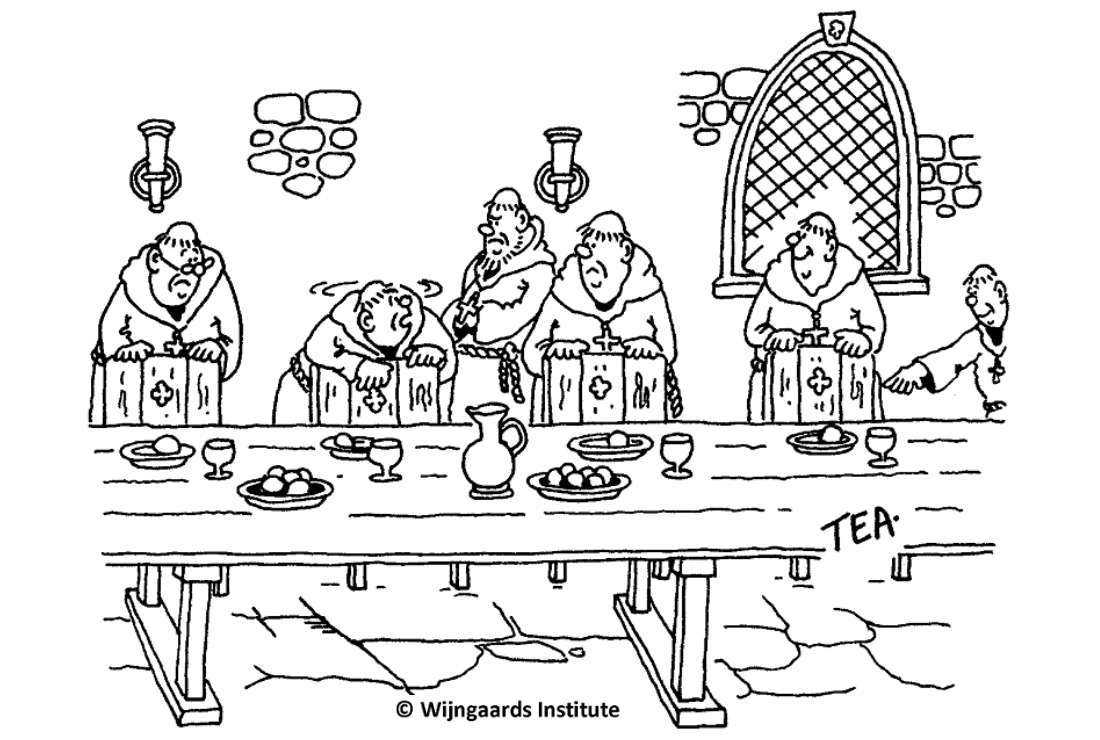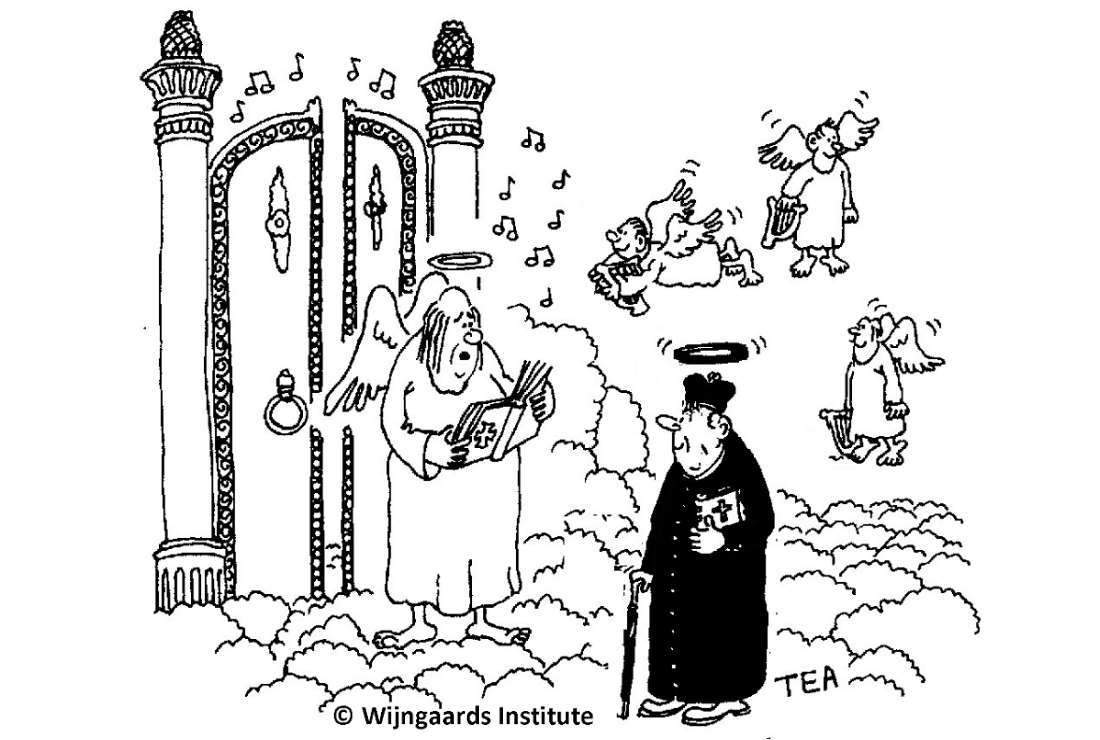Are Church leaders aware of the enormous cultural and social differences between various countries and continents?

“I suddenly grasp: if the Church is a ‘Mother Church’, she can give birth to a variety of infant churches!” (Illustration: Tom Adcock)
“Jesus stood and said in a loud voice, ‘Let anyone who is thirsty come to me and drink. Whoever believes in me, as Scripture has said, rivers of living water will flow from within them’.” (John 7,37)
From 1964, I taught at St. John’s Major Seminary, Hyderabad, India, for almost two decades. During that time I got to know many parishes there. This story is about a parish that lay on the outskirts of the city.
You must remember that during that period, many reforms initiated by the Second Vatican Council were being implemented. They affected the liturgy in many ways. Not only could the Eucharist now be celebrated in one of the local languages, many cultural customs were being introduced.
The parish priest of the parish in question, whom I will call Chinnappa Reddy, looked after the main Italian-style church in the built up area of the town. But he also had to care for outstations in villages lying outside the city boundaries.
Reddy told me that there was a world of difference in the way the Eucharist was celebrated in the centre and outside town.
“People in our main church come from many different backgrounds”, he said. “They are also used to the way Mass has been celebrated in the past. They come in and genuflect as they used to do before. I say Mass in English. Our choir presents English hymns, but occasionally they revert to the old well-known Latin songs. I distribute Holy Communion on the hand but also on the tongue.”
“In the outside villages it’s a totally different story. At Mass everyone sits on the floor round a low altar, Indian style. The prayers are in Telugu. We use Indian gestures. We don’t genuflect, we bow.”
Knowing that I myself was used to celebrating Indian-style Masses, he invited me to preside at a local village on a Sunday. I did.
It was a wonderful experience. It took place in a school hall. I sat cross-legged on the floor behind a low altar. The whole congregation surrounded me, all sitting on the floor. At the beginning of the Mass a local teacher lit an Indian oil lamp, the deepam, in front of the altar. The readings and prayers were all in Telugu. At the offertory, children brought up bread and wine, as well as flowers with which I could decorate the altar. Incense was used to honor the sacred gifts while I performed the arati, the rite by which the gifts are lifted up and moved round in a circle. During the words of consecration, people got up on both knees and made a deep bow. At communion people would take a host and dip it into the consecrated wine before consuming it.
“Some persons criticise me for maintaining the old order in our main church”, Reddy said to me. “I think they are wrong. Each section of the community deserves to be treated the way that corresponds to their needs. Uniformity would be a mistake.”
Regional variations
In recent centuries there has been a trend in the Catholic Church to be obsessed by ‘uniformity’. Of course, we are One Holy Catholic Church. And yes, the same basic doctrines of faith apply everywhere. But there is no reason why, as far as customs and practices are concerned, there should not be more regional variation between countries and continents.
In fact, there are already such differences.
The Lebanon’s Catholic Maronite Rite allows married men to be ordained priests. And there are striking variations in the way the Eucharist is celebrated in the Catholic Syriac Rite of the Syro-Malabar community in India and the Catholic Alexandrian Rite in Egypt and Ethiopia.
Moreover, the Second Vatican Council introduced the use of everyday language in each country or part of a country, with other cultural adaptations.
What did Jesus think about it?
Jesus public ministry lasted only for three years. Moreover, no established church communities had yet been set up. So, we cannot make a parallel with the specific needs of later times, especially when the Christian faith took root worldwide. Still we can learn from Jesus’ attitude and way of acting.
Galilee and Judea, both provinces of Palestine, contrasted markedly in Jesus’ time. Galilee was rural, Judea heavily urbanised. Jesus was well aware of it. He adapted his approach to do justice to the needs of each.
Galilee in fact was looked down upon by many Palestinians. “Can anything good come from Nazareth?!”, Nathanael exclaims (John 1,46). Galileans downrated themselves. When Jesus proclaimed his mission in the synagogue of Nazareth, the other villagers reject him. “Is he not the carpenter’s son? Is his mother not called Mary? And are not his brothers [relatives] James and Joseph and Simon and Judas? And are not all his sisters with us? Where then did this man get all these things?” (Matthew 13,15-58). Because most Galileans lived from farming, fishing and tending flocks of sheep, it is in Galilee that Jesus presents parables based on those crafts.
On the other hand, Judea enjoyed a more sophisticated, urbanised life style. The temple at Jerusalem dominated the region, not just religiously, but also economically. Because income from tourists and pilgrims brought wealth to the region. Jesus recognised those traits and consciously adapted his approach accordingly. The infancy story of Jesus as a boy questioning the priests in the temple (Luke 2,41-52) foreshadows that.
The Jews celebrated the Feast of Tabernacles to give thanks for their crops, but also God’s promise that he would tabernacle (dwell) among them. During that feast Jesus appeared in the temple (John 7,1-52). In the crowded temple courts he proclaimed in effect that the Father was tabernacling (living) in himself. And on the final day, when water was carried into the temple from the pool of Siloam, “Jesus stood and said in a loud voice, ‘Let anyone who is thirsty come to me and drink. Whoever believes in me, as Scripture has said, rivers of living water will flow from within them.’ By this he meant the Spirit, whom those who believed in him were later to receive. Up to that time the Spirit had not been given, since Jesus had not yet been glorified” (John 7,37-38).
Again, Jerusalem was used to festive processions with palms into the temple area. Originally the Ark of the Covenant, on top of which Yahweh’s invisible presence was believed to reside, would be carried into the temple, re-enacting its first entry under King David. In Jesus’ time one annual event commemorated the liberation of Jerusalem under the Maccabees in 141 BC (1 Maccabees 13,51-62). Jesus deliberately imitates this custom when entering Jerusalem sitting on a donkey and surrounded by people wearing palms. People chanted: “Hosanna to the Son of David. Blessed is he who comes in the name of the Lord” (Mark 11,1-11).
Questions
Are Church leaders aware of the enormous cultural and social differences between various countries and continents?
When reforms in Church practice are agreed upon, should the implementation of these reforms be imposed everywhere at the same time? Or should the bishops’ conferences in those countries and continents not be allowed to introduce changes gradually according to local needs and requirements?
Published by arrangement with the Wijngaards Institute for Catholic Research
*The views expressed in this article are those of the author and do not necessarily reflect the official editorial position of UCA News.










